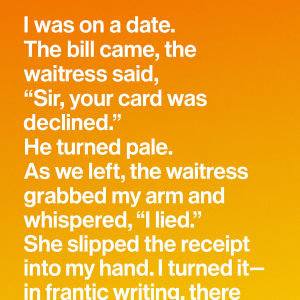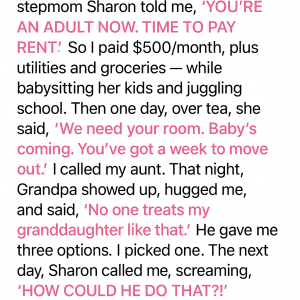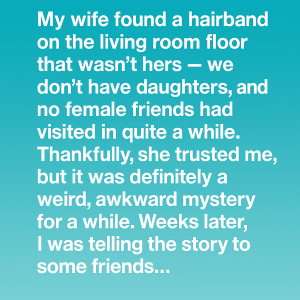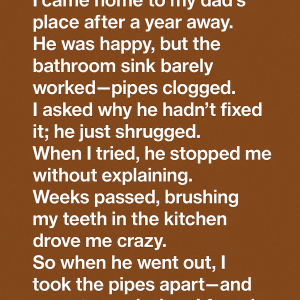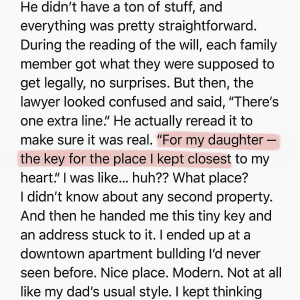I still remember the day I told my parents I wanted to study art instead of business.
My father set down his coffee slowly, his expression hardening. My mother just shook her head, disappointment written all over her face. “You’re wasting your potential,” Dad said flatly. “Art? That’s not a career. That’s a hobby.”
They had it all planned out—the university I’d attend, the business degree I’d earn, the “respectable” job that would follow. But standing in our kitchen that morning, my portfolio tucked under my arm, I knew I couldn’t live someone else’s version of my life.
“I need to do this,” I told them quietly.
The silence that followed was brutal.
Within two weeks, I’d packed what little I owned—a secondhand laptop, my sketchbook collection, and a backpack of clothes—and moved into a tiny studio apartment across town. At 18, I was on my own, completely. No financial support. No safety net. Just me and a stubborn belief that I could make this work.
The first year was humbling in ways I never expected.
I worked at a coffee shop during the day, slinging lattes and cleaning tables. At night, I delivered food on my bike until my legs ached. Between shifts, I designed—logos for startups that could barely pay me, flyers for local bands, social media graphics for friends of friends. I lived on instant noodles and day-old pastries from work. Some nights, I’d lie awake wondering if my parents had been right all along.
But I kept drawing.
Every rejection taught me something. Every small win kept me going. A $50 logo job became a $100 website design. A happy client referred me to another. Slowly—painfully slowly—my portfolio grew stronger. I learned to take criticism without crumbling. I learned that perseverance meant showing up even when no one was watching.
Then, about three years in, something shifted.
I’d designed a poster for a small animal rescue nonprofit—mostly as volunteer work because their mission moved me. They posted it online, thanking me by name. Within days, my inbox was flooded. Animal shelters. Community centers. Small businesses who loved the warmth and honesty in my work. The phone started ringing. Real clients. Real budgets.
For the first time since leaving home, I could breathe.
I hired a friend to help with administrative work. Then another designer. We moved into a modest office space with good light and room to create. Each project became a chance to grow—not just as a designer, but as a person who was learning what it meant to build something from nothing. I wasn’t chasing fame or fortune. I was chasing the simple freedom of doing work I believed in.
Five years after leaving home, I had a small but thriving design studio.
One afternoon, my assistant knocked on my office door. “There’s a couple here without an appointment,” she said. “They’re asking if we can help with some design work.”
I grabbed my notepad and walked into the reception area.
The moment I saw them, my heart stopped.
My parents stood there, older and smaller than I remembered them. My mother’s hair had gone gray at the temples. My father’s shoulders seemed less certain, less commanding. They looked up when I entered—and the shock on their faces mirrored my own.
“Is that… is that really you?” my mother whispered.
I nodded, unable to speak for a moment.
They looked around the studio—at the framed client work on the walls, the awards on the shelf, the busy hum of a business that was undeniably real. My father’s eyes moved from piece to piece, taking it all in. My mother’s hand went to her mouth.
“You did all this?” she asked, her voice breaking.
“I did,” I said quietly. “With a lot of help and a lot of late nights.”
We stood there in silence, the weight of five years pressing into the space between us. I could have been angry. Part of me wanted to remind them of every doubt they’d voiced, every door they’d closed. But standing there, looking at their faces, I realized something important: I didn’t need their apology. I didn’t need them to admit they’d been wrong.
I’d already proven what I needed to prove—to myself.
“I hope you’ve both been well,” I said gently. “I really do.”
My mother’s eyes filled with tears. My father nodded slowly, his jaw tight with emotion he didn’t know how to express.
Before they left, I told them something I’d learned the hard way: “You don’t need anyone’s permission to build a life that’s true to who you are. Not even from the people you love most.”
After they walked out, I stood in my studio for a long time, looking at everything I’d created.
The late nights. The fear. The ramen dinners and the rejection emails and the moments I’d wanted to quit. All of it had led here—to a space I’d built from scratch, doing work that made me proud.
Success, I realized, was never about proving anyone wrong.
It was about trusting yourself enough to take the hard road—and refusing to give up when the world told you to turn back.
Final Reflection:
Sometimes the greatest gift we can give ourselves is the courage to disappoint others in pursuit of our own truth. It won’t be easy, and it won’t be fast—but when you finally stand in the life you’ve built with your own hands, every difficult step will have been worth it.
Disclaimer:
This article shares a personal story inspired by real-life experiences. Names, details, and specific circumstances have been crafted to protect privacy while conveying authentic emotional truths about following unconventional paths and finding validation from within.
